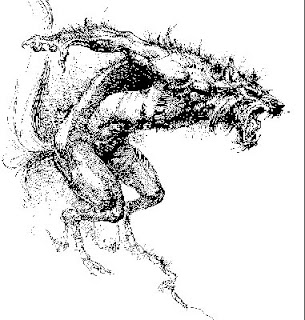Vampires, and Werewolves, and Mummies, Oh My!
Last night my street was teeming with monsters and demons of the night. Witches were sighted with steaming and fowl smelling caldrons, vampires lurked in the shadows, and the howls of werewolves broke the night’s soothing silence. True, these monsters were only children out for some candy, but it stuck me that we need to be ready when one of these real monsters arrives, as they undoubtedly (or possibly, or maybe) will. So, myself, my husband, and Ginny, our crime fighting dog, caucused to determine the most dangerous monster. We intend to be ready.
But ready for which monster? We eventually need to be ready for all of these monsters, but believe we must be ready for the most dangerous first. We need to determine the set of monsters that can attack human and analyze the strengths and weaknesses of each. There have been so many documentaries that some become questionable. Some are contradictory. Some appear to be from questionable sources. I will use my own judgment to sort fact from fiction.
I believe the primary candidates are vampires, werewolves, and mummies. There are many others of course, but the limited documentation makes me suspect that they may not be real, but fictional.
Vampires Strengths and Weaknesses: Vampires are incredibility strong, can fly, can change shape and form, and are very difficult to kill. They can form a team, as shown below from the documentary “Lost Boys”. The vampires from “30 Days of Night” provide another example of vampires’ ability to band together to reach a common goal. Vampires are difficult to recognize as long as they use proper dental hygiene, keep their fast growing nails short, and have a reasonable explanation why they only show up at night.
But vampires must eat and cannot appear in the daytime. They are dependant on either help to guard their caskets or very secret locations to protect them as they sleep. They also seem to expose themselves because of their attraction to beautiful women and draw attention themselves as they behave like grammar schoolboys with their first crush. They must also keep their numbers limited because they easily begin to outnumber the food source which seems to be us.
Werewolves Strengths and Weaknesses: The werewolf is like your family dog on steroids with a control issue. Standing over seven feet tall, strong, an insatiable hunger for human flesh, fast, and has an attitude the Dog Whisperer couldn’t handle. In France, the creature was described as a giant wolf that killed upwards of 80 men, women, and children in the 1700s.
However, if you pool the family jewelry, the beast is easily brought down with silver bullets. They seem to end their nocturnal activities lying on the ground, naked and shivering. I don’t have data to prove it, but I’m thinking that a bunch of these guys must die of colds and flues.
Mummies Strengths and Weaknesses: Mummies are just dead guys that slowly walk around wrapped in gauze. Their lack of speed requires them to be ambush hunters for old, slow doctors. They looked like you could run in with a match and set them on fire and then rush out before they could react. The 1999 evidence shows mummies with substantially more strengths and weaknesses. They can rather easily overcome large population but can be destroyed with a few magic works.
Criteria: World Domination
Vampires don’t really want world domination. They think of us as blood bags (except for their romantic tendencies.) Werewolves are primarily in hunt mode while in the creature form. When in the human mode, they feel guilty about their primitive activity. Only the mummy might want a world of slaves.
Criteria: Scariest – When you meet the monster face to face, which scares you the most
The mummy, post 1999 form, looks like a handsome guy so I don’t fear his appearance. Vampires generally look human, but that actually is a scary. Everyone you know could be a bloodsucker and you wouldn’t know until it’s too late. The werewolf clearly has the most frightening appearance. Combined with intent to eat you right now, he is the scariest.
Criteria: Bloodiest – When the police show up at the crime scene, which monster leaves the bloodiest kill zone?
The vampire leaves a fairly pristine victims with just two fang marks one the neck. The torn and shredded body of the werewolf’s victim is seldom attractive. Mummies now leave a shrunken body that looks like, well, a mummy.
Criteria: Can we prepare for them?
It takes little time to prepare for werewolves. Just start making those silver bullets. It takes almost nothing to prepare for a mummy. Just keep control of the “Book of the Dead” and send him right back when he shows up. Preparing for vampires is hardest as there is an identification before you can actually kill these guys.




